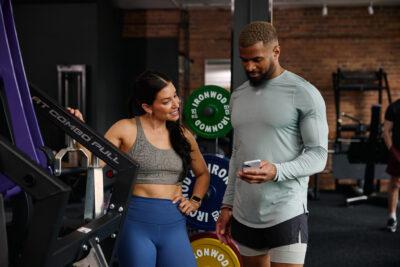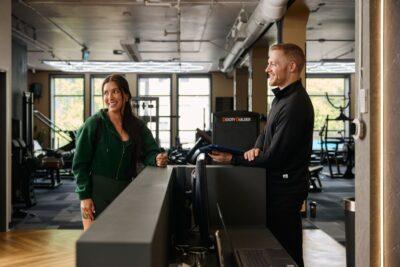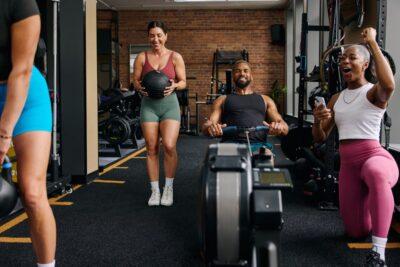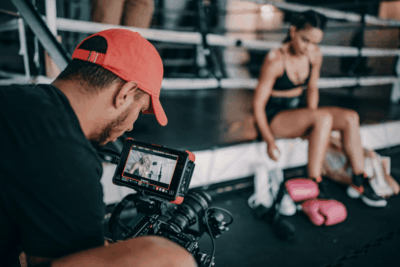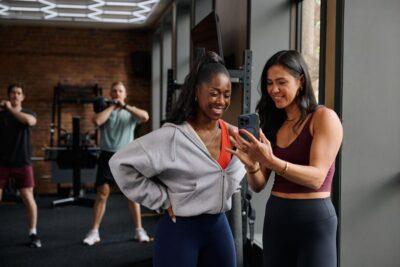Branded gym merchandise excels in two key areas: it drives revenue and fosters brand loyalty among your members.
When someone proudly wears your logo to the grocery store, on a hike, or in a sweaty mirror selfie, that’s not just a sale, it’s a statement. They’re saying, “This is my gym. This is my people.” And that kind of visibility is something you can’t buy with ads.
At the same time, merchandise can be one of the easiest, most reliable revenue streams your gym has. With smart sourcing, clear pricing, and minimal overhead, merch adds income without eating into your time or margins.
And in a fitness world that’s more lifestyle than ever, this isn’t optional anymore. Nobody would reject gymwear that is good quality, cool, and comes from their chosen brand. This guide will walk you through exactly what to sell, how to brand it, where to sell it, and how to make it part of your culture, not just your counter.
What to Sell: Best-Selling Gym Merchandise Ideas
Don’t overthink your product line. The best gym merchandise is simple, functional, and solves a real need. Focus on what gear members already want, not on designing weird one-off items no one asked for.
Think: “What would help them avoid laundry today?”
If it soaks up sweat, holds a water bottle, or saves them a trip home to change clothes, it’ll sell.
Gym Merchandise Staples
- Branded apparel: Tees, tanks, hoodies, crop tops, beanies, hats
- Towels: Extra absorbent, compact, branded
- Reusable water bottles and shakers
- Lightweight gym bags or totes
- Yoga mats or resistance bands for home workouts
- Seasonal items: Warm layers in winter, breathable pieces in summer
Optional Add-Ons (If Relevant to Your Gym or Studio)
- Snacks, supplements, or protein bars: (They come very handy to whoever is busy, so why have a different brand when you can make your own? Just make sure to check regulations and brand reputation.)
- Branded notebooks or habit trackers
- Gift cards, starter bundles, or “challenge kits”
Read More: This Is Why You Need to Sell Sports Products at Your Gym
Design and Branding Tips for Gym Merchandise
There’s no one way to create great merch. It depends on how much time, skill, and budget you have, and which parts of the process you want to outsource.
Here are three ways gym owners typically approach it:
#1: Do It Yourself (with tools like ChatGPT + Canva)
- Use ChatGPT to brainstorm slogans, member quotes, or product ideas
→ But first, feed it your brand voice, gym values, and community vibe - Use Canva to turn those ideas into mockups
- Find a local printer, dropshipper, or on-demand partner to produce it
#2: Outsource the Visuals, Manage the Rest
- Hire a freelance designer or merch specialist to handle branding and layout
- You still decide on product types and manage sourcing, pricing, and orders
#3: Fully Outsource the Process
- Work with companies that handle everything: concept, design, sourcing, and fulfillment
- Best if you want hands-off execution with a consistent, professional result
5 Design Best Practices (No Matter Who Does It)
#1: Keep the Design Simple and Minimalist
Overcomplicated designs can cheapen your brand. Stick to clean lines, subtle branding, and avoid oversized logos that scream “merch.” A small, well-placed logo on quality fabric says more than a block of text ever will. Prioritize comfort and wearability over trying to be clever.
#2: Use Slogans That Actually Resonate
Short, motivating phrases perform better, especially when they feel authentic to your gym community. If your gym already has a tagline, start there. You can also source quotes from your members or inside jokes that only your people get; those are the ones that actually sell.
#3: Prioritize Fit and Comfort
Fit is half the battle. Offer a mix of unisex and gender-specific cuts, and avoid generic one-size-fits-all gym merch options, which rarely fit anyone well. If you’re selling in-studio, provide size charts or allow try-ons so people can buy with confidence.
#4: Make It Feel Exclusive
Use scarcity to build demand. Limited drops, seasonal pieces, or “only 50 available” campaigns create urgency without forcing a hard sell. People want to wear something that feels rare, not mass-produced. Let them know when the next drop is coming, and stick to it.
$5: Put Real People in It
Skip the polished models and use your actual community. Feature instructors and members wearing the gear on social, in workouts, and around the gym. Repost their photos, tag them, and make your merch part of your gym’s everyday vibe, not just something you post about when it’s new.
Pricing & Profit Margins
A lot of gym owners start selling merch for fun, to build community, boost gym pride, or just because they love gym wear. But if you do it right, it can also become a profitable, consistent side revenue stream that doesn’t rely on training hours or class packages.
Here’s how to make your pricing and production model work for you:
Price for profit, not just vibes
Most gym owners undercharge because they’re afraid to look greedy. But merch is retail, you need margin. Also, higher prices (when justified with quality and design) create a perception of exclusivity.
A good rule: charge 2–3× your cost of goods (COGS). For example, if a hoodie costs you €20 to make, sell it for €50–€60, depending on quality and perceived value. That gives you room to cover processing fees, tax, and still walk away with a profit.
Use margin targets, not just markups
Aim for a 50–65% margin on apparel, 40–60% on accessories like bottles or bags, and around 30–40% on consumables like snacks or supplements. Don’t guess, use the formula:
Price = COGS ÷ (1 – margin target)
Example: €12 tee with 60% margin → €30 price point.
Bundle to increase average order value (AOV)
Another best practice is to combine a high-margin item (like a tee or towel) with a lower-margin one (like a shaker or bag) and offer a small discount. This increases your average cart size and gives members a sense of value, without eating into your profits.
Bonus: Bundles also work well as loyalty gifts, referral rewards, or challenge prizes.
Use Pre-Orders to Test, and Then Let Data Drive Decisions
Start with a 7–10 day pre-order window to test interest. Collect payment upfront and only produce what’s been paid for. This keeps your cash flow healthy and avoids dead stock.
Once the merch is live, track which SKUs are actually selling. After 30–60 days, double down on your best-sellers and cut the ones that aren’t moving. Don’t overcomplicate your catalog; too many options slow down sales and lead to waste. Let the numbers guide what comes next.
Your production model affects your margin and time. You have three main options:
Print-on-demand / Dropshipping
- No upfront inventory, very little effort
- Margins are lowest (often 30–45%)
- Slower shipping and fewer customization options
Local bulk production
- Order higher quantities, get better per-unit pricing
- Margins often sit around 50–65%
- You’ll need to invest upfront and store the product
Full-service partner
- They handle design, sourcing, and fulfillment
- Medium margin, low effort, but less control
- Ideal if you want a polished result without managing vendors
Account for hidden costs. When setting prices, don’t forget to include:
- VAT/sales tax you might pay in your country
- Payment processing fees if you’re using Stripe, PayPal, etc.
- 5–10% buffer for shipping, overages, returns, or damaged items
How to Sell Merchandise in Your Gym
Selling merch inside your gym starts with visibility and ease. If it’s not obvious, accessible, and integrated into your space, it won’t move. Here’s how to actually get your products off the shelf and into members’ hands:
- Set Up a Clear Point of Sale
Use your front desk, check-in area, or lobby as a mini retail hub. Make sure staff can take payments on the spot, whether that’s through a POS system, mobile reader, or QR code. Keep your best-sellers within reach and in high-traffic zones, like near the towel station or water cooler.
- Build a Clean, Branded Display
Create a small retail wall or rack. Use shelving, hooks, mannequins, and folding tables to showcase key pieces. Keep it styled but simple: a few neatly folded tees, hanging hoodies, maybe a mirror for try-ons. Rotate new drops seasonally to keep things fresh and relevant.
- Let Coaches Model the Gear
Have your instructors and coaches wear new merch while they’re teaching or training. It builds social proof and shows how the pieces look in action. Take quick photos or short Reels to share on social, and use shelf signage like “Worn by Coach Jamie – Limited Run” to tie it all together.
- Use Light In-Gym Promotion
You don’t need a full pitch. Just add small signage near lockers, bathrooms, or your front desk. Mention new merch during gym tours or program launches. If you have digital signage, rotate product highlights alongside class promos.
- Use Merch to Reinforce Other Goals
You can also tie merch into your existing systems:
- Offer discounted or free merch as part of referral rewards
- Give milestone gifts (e.g., free shirt after 100th class)
- Bundle it into challenge prizes or loyalty programs
How to Sell Gym Merchandise Online
Selling merch inside your gym is a great start, but if you want to increase reach, automate purchases, and keep sales going outside of class hours, you need to sell online. Whether you’re using a standalone shop or integrating with your member platform, online sales give your merch a longer life and wider visibility.
Start by setting up an online storefront: This can be as simple as a Shopify site, a page on your gym’s website, or a store connected to your member app, especially if you’re using a system like ABC Glofox that allows for integrated member portals. The key is that it’s easy to browse, mobile-friendly, and built to convert quickly.
Promote your merch the same way you’d promote a class or challenge. Mention it in your welcome emails, highlight new drops in your weekly newsletters, and push flash sales or low-inventory alerts through SMS and Instagram stories.
Don’t just announce a product, show members how it fits into their routine. Feature gear in your challenge bundles, use instructors to model items in video content, and show real members wearing it in everyday life.
Include merch as part of onboarding packages. New member joins? Give them the option to add a discounted hoodie or branded towel at checkout. Hosting a transformation challenge? Create a bundle with a tank, shaker, and journal that ties into the program, and give it a dedicated landing page to sell it.
To keep things organized, batch product drops seasonally. Promote limited collections with countdowns or first-come, first-served access to keep things exciting. Even if your online store is simple, the psychology behind a good launch still applies: urgency, exclusivity, and clear member benefits.
Finally, make sure checkout is seamless. If you’re using Glofox or similar, members should be able to buy merch directly through your app, using saved payment info. No extra steps, no new account creation—just scroll, tap, purchase.
Read More: How to Make the Most of Your Fitness Merchandise
Make Gym Merch Part of Your Culture
If you want merch to sell, make it visible and quick to buy. Have instructors wear it during class. Launch new drops around events or challenges. Promote it like you would a program, not just a product.
Repost members who wear your gear. Start a hashtag. Use merch as rewards for referrals or milestones. Don’t let it sit folded at the front desk. Make it part of the gym experience every day.
At the end of the day, merch can become a powerful retention, revenue, and brand visibility engine rolled into one.
When it’s done right and certain conditions favour it, it doesn’t just bring in extra cash, it strengthens your community, increases loyalty, and turns your members into your best marketing asset.
Start small. Keep it simple. Focus on quality, not quantity, and build from there.
Want to simplify how you manage merch, members, and marketing in one place?
See how ABC Glofox helps you streamline it all, online and in-gym, without adding to your workload.



